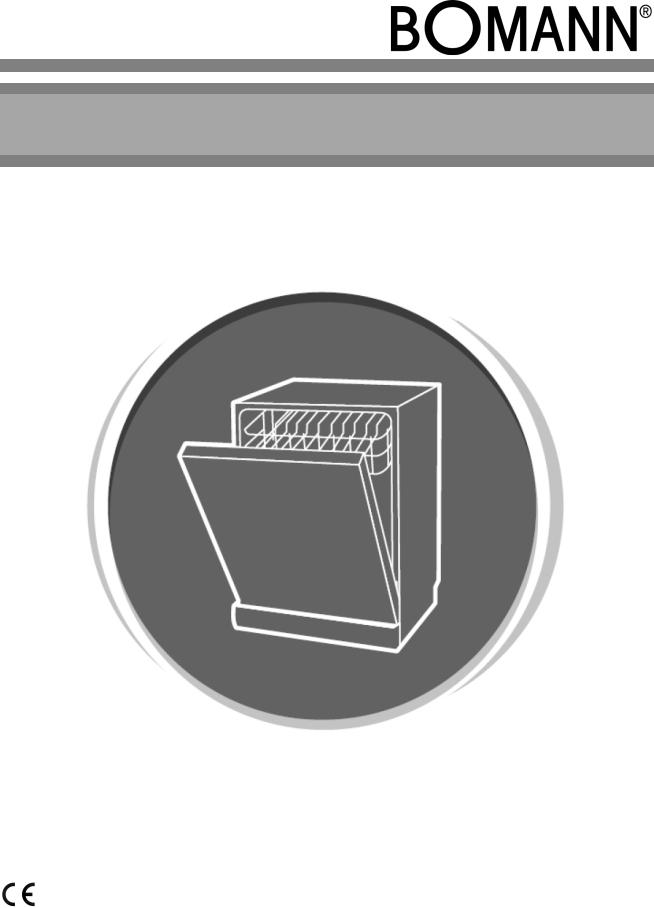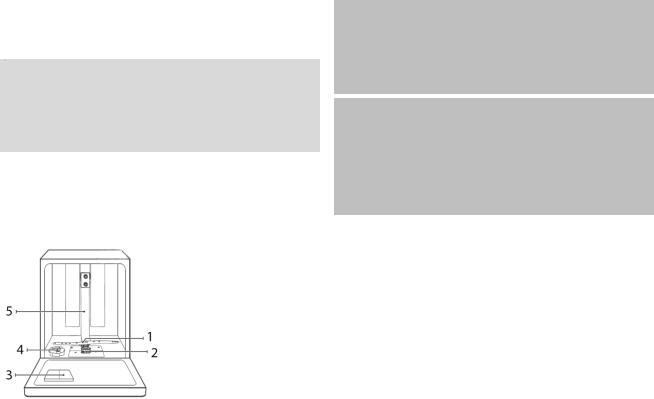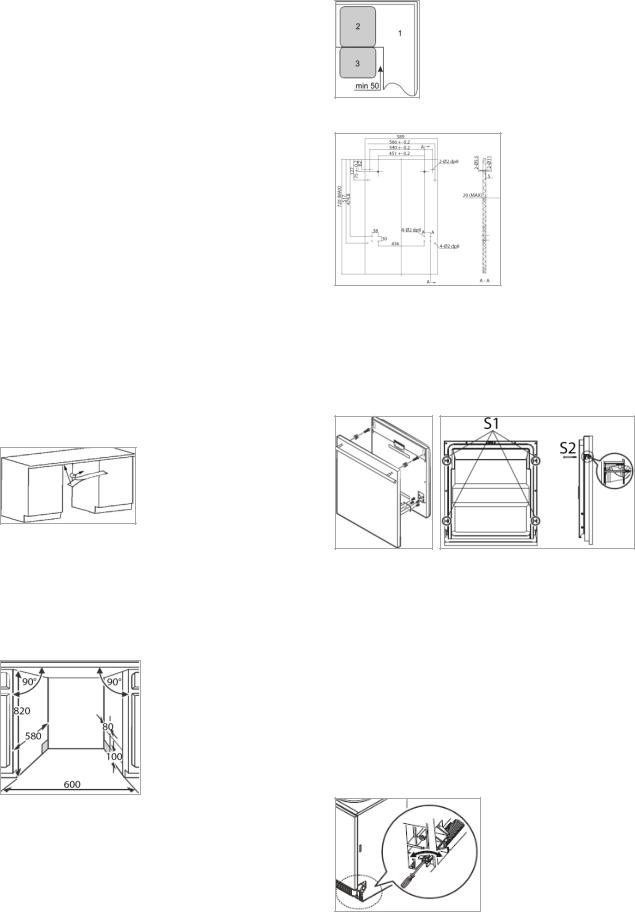Bomann GSPE 892 operation manual

HOUSEHOLD BUILT-IN DISHWASHER GSPE 892
Instruction Manual
Contents
Introduction ……………………..………………….………………………………………………….….... |
Page 3 |
|
General Notes …...……………………………………….……………………………………………..…. |
Page 3 |
|
Special safety Information for this Unit ……………………………...…………………………….......... |
Page 4 |
|
Unpacking the Appliance ….……………………………..…..…………………………………………… |
Page 5 |
|
Appliance Equipment ……………………..….………………………………………………………….... |
Page 5 |
|
Installation …...…………………………………………………………………………………………..…. |
Page 5 |
|
Prior Using for the first Time ……………………………………………………………………………… |
Page 8 |
|
Loading the Dishwasher ………………………………………………………………………………….. |
Page 10 |
|
Startup / Operation ……………………..………………………………………..………………….......... |
Page 12 |
|
Cleaning and Maintenance …...……………………….…..……………………………………………… |
Page 14 |
|
Troubleshooting |
……………………..………………......……………………………………………….... |
Page 16 |
Technical Data |
…...………………………………………...………..…………………...……………..…. |
Page 17 |
Disposal …...………………………………..………………..……………………………..……………… |
Page 17 |
|
EU Product Data Sheet .....………………………..………..……………………………..……………… |
Page 18 |
|
2

Introduction
Thank you for choosing our product. We hope you will enjoy using the appliance.
Symbols in these Instructions for Use
Important information for your safety is specially marked. It is essential to comply with these instructions to avoid accidents and prevent damage:
 WARNING:
WARNING:
This warns you of dangers to your health and indicates possible injury risks.
 CAUTION:
CAUTION:
This refers to possible hazards to the machine or other objects.
 NOTE: This highlights tips and information.
NOTE: This highlights tips and information.
and disconnect the plug (pull the plug itself, not the lead) or turn off the fuse.
•The appliance and if possible the mains lead have to be checked regularly for signs of damage. If damage is found the appliance must not be used.
•For safety reasons, alterations or modifications of the appliance are prohibited.
•In order to ensure your children’s safety, please keep all packaging (plastic bags, boxes, polystyrene etc.) out of their reach.
 WARNING:
WARNING:
Do not allow small children to play with the foil. There is a danger of suffocation!
General Notes
Read the operating instructions carefully before putting the appliance into operation and keep the instructions including the warranty and the receipt. If you give this device to other people, also pass on the operating instructions.
 NOTE:
NOTE:
Illustrations can deviate from the original appliance.
•The appliance is designed exclusively for private use and for the envisaged purpose. This appliance is not fit for commercial use.
•The appliance is only to be used as described in the user manual. Do not use the appliance for any other purpose. Any other use is not intended and can result in damages or personal injuries.
•Operate the appliance only properly installed.
•Do not use it outdoors. Keep it away from sources of heat, direct sunlight and humidity.
•Do not operate the appliance without supervision.
•When not in use, for cleaning, user maintenance works or with disruption, switch off the appliance
3
Special safety Information for this Unit
•The maximum number of place settings to be washed is 12.
•This unit is intended to be used in household and similar applications such as
-staff kitchen areas in shops, offices and other working environments;
-by clients in hotels, motels and other residential type environments;
-in farm houses.
•The appliance is to be connected to the water mains using new hose sets and that old hose-sets should not be reused.
•The maximum permissible inlet water pressure is 1 Mpa.
•The minimum permissible inlet water pressure is 0.04 Mpa.
•In the appliance bottom are located ventilation openings (depending on model). These may not be clogged e.g. by carpet.
•Pay attention to a proper loading of the appliance. Follow the instructions in the chapter “Loading the Dishwasher”.
•Knives and other utensils with sharp points must be loaded with their points down in the cutlery basket (depending on model) or placed in a horizontal position in the dishwasher basket.
•The door should not be left open, since this could increase the risk of tripping.
•This appliance can be used by children aged from 8 years and above and persons with reduced physical, sensory or mental capabilities or lack of experience and knowledge if they have been given supervision or instruction concerning use of the appliance in a safe way and understand the hazards involved.
4

•Children who are younger than 8 years must be kept away from the device.
•Children shall not play with the appliance.
•Cleaning and user maintenance shall not be made by children, unless they are older than 8 years and are supervised.
•Do not try to repair the appliance on your own. Always contact an authorized technician. If the supply cord is damaged, it must be replaced by the manufacturer, its service agent or similarly qualified persons in order to avoid a hazard.
Unpacking the Appliance
•Remove the appliance from its packaging.
•Remove all packaging material, such as foils, filler and cardboard packaging.
•To prevent hazards, check the appliance for any transport damage.
•In case of damage, do not put the appliance into operation. Contact your distributor.
 NOTE:
NOTE:
Production residue or dust may have collected on the appliance. We recommend cleaning the appliance according to chapter “Cleaning and Maintenance”.
Appliance Equipment
Appliance Overview
1 Lower spray arm
2 Filter system
3 Dispenser
4 Salt container
5 Inner pipe
Delivery scope
1x Cutlery basket, 1x cup shelf, 1x salt funnel tube, 1x inlet hose safety system, installation material
Installation
 WARNING:
WARNING:
The unit must not be connected to the mains during installing. Otherwise there is danger to life or electric shock hazard!
 CAUTION:
CAUTION:
For a correct operation the appliance must be connected properly. The specifications for water supply and drain as well as the electrical connection must fulfill the required criteria.
Installation location
•The site should be located near the water inlet and outlet, as well as near a properly grounded power socket. Arrange a place in the cabinet under the sink for the cable and hoses.
•Consider the necessary installation dimensions (see “Installation steps”).
5

•Take care of a solid and horizontal position of the appliance. If the appliance is not horizontally leveled, adjust the feet accordingly.
•Power cord and water hoses may not kinked or squashed.
•Avoid the installation:
-near heaters, next to a stove, direct sunlight or any other heat sources;
-at locations with high humidity (e.g. outdoors), as metal parts would be susceptible to corrosion under such circumstances;
-in rooms where the temperature could drop below freezing. Do not expose the appliance any weather.
-near volatile or flammable materials (e.g. gas, fuel, alcohol, paint, etc.).
Installation steps
Attach the condensation strip
Attach the strip under the wooden worktop to prevent it from damages of ascending water vapor.
•First clean and dry the concerned area of the worktop thoroughly.
•Remove the protective foil from the condensation strip and stick it flush with the worktop edge.
Cabinet opening
Prepare the cabinet opening according the drawing.
Unit mm
If the appliance is installed at the corner of the cabinet, there must remain enough space to open the appliance door.
1Kitchen furniture
2Dishwasher
3Appliance door
Unit mm
Dimension and preparation of the decoration panel
Prepare the wooden decorative panel according to the dimensional drawing.
Unit mm
•Align the drilling template and mark the necessary holes. Check this with a spirit level.
•Drill holes of Ø 2 mm and 8 mm depth at the premarked positions in the panel.
Fixing the decoration panel
•Insert the brackets into the holes of the decorative panel and turn the screws in.
•Hook the decorative panel with the brackets into the provided slots on the appliance front.
•Align the panel and the appliance front against each other and fix the panel on the unit door.
•First remove the factory-mounted short screws (4xS1) from the door inside.
•Screw the supplied long screws (4xS2).
Adjusting of the door spring tension
After fixing the decoration panel, the door spring tension must be adjusted accordingly.
6
